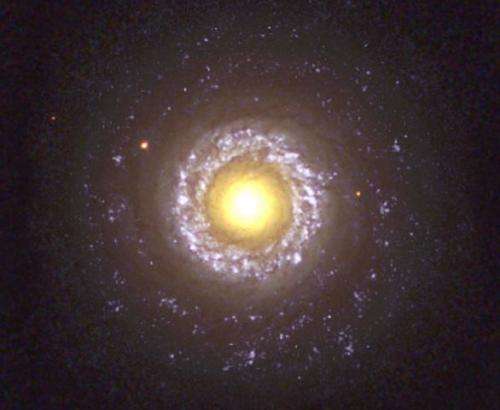A Hubble image of the Seyfert galaxy NGC 7742. A new paper argues that the existence of two types of Seyfert galaxies may be the result of their different physical mechanisms, and not simply differences in viewing angles. Credit: NASA/Hubble Space Telescope
(Phys.org) -- Seyfert galaxies are like normal galaxies, our own Milky Way included, except in one critical respect: their nuclei are fantastically bright. In some instances they are as luminous as 100 billion Suns, though even the weakest Seyfert nuclei are as luminous as a million Suns. Scientists believe that these huge energies are being generated by a massive black hole in the nucleus, not an ensemble of stars. Matter, as it falls in towards the vicinity of the black hole, heats up and glows intensely. Astronomers think our Milky Way also has a massive black hole at its center, but (for reasons that are not yet entirely understood) our galactic center is not particularly bright.
There seem to be two types of Seyfert galaxies: those whose bright nuclei also emit light from highly excited atoms moving at high velocities (providing evidence for extreme conditions) and those without these atomic lines. The most widely accepted explanation for these two types is the so-called "unification model": The galaxies are intrinsically the same, but in the former the disk-like galaxy is seen face on and its nucleus is visible, while in the latter the galaxy is seen edge-on and the nucleus and its atomic emission is obscured by dust.
In the decades since it was first proposed, the unification model has gradually encountered increasing criticism from astronomers who argue that there may also be something physical going on to create the different kinds of Seyferts. CfA astronomers Andrea Marinucci, Fabrizio Nicastro, and Andy Goulding, with two colleagues, have analyzed data on a set of thirty-nine Seyferts using what they consider more reliable measures of the nuclear activity in the atomic lines. They provide evidence in the latest issue of the Astrophysical Journal that the accretion rate also differs in the two types. If confirmed, this conclusion would mean that there are physical differences between objects in the Seyfert family, and that viewing angle is not the only story.
Provided by Harvard-Smithsonian Center for Astrophysics


.jpg)





















